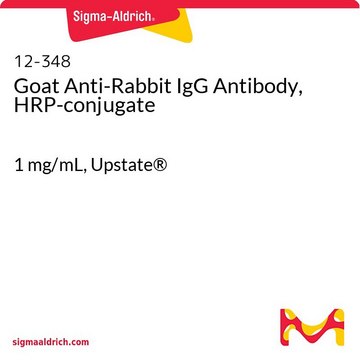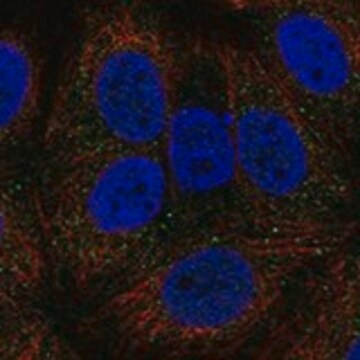MABE1121
Anti-Ago1 Antibody, clone 4B8
clone 4B8, from rat
Sinônimo(s):
Protein argonaute-1, Argonaute1, hAgo1, Argonaute RISC catalytic component 1, Eukaryotic translation initiation factor 2C 1, eIF-2C 1, eIF2C 1, Putative RNA-binding protein Q99, Ago1
About This Item
Produtos recomendados
fonte biológica
rat
Nível de qualidade
forma do anticorpo
purified immunoglobulin
tipo de produto de anticorpo
primary antibodies
clone
4B8, monoclonal
reatividade de espécies
human
técnica(s)
western blot: suitable
Isotipo
IgG2aκ
nº de adesão NCBI
nº de adesão UniProt
Condições de expedição
wet ice
modificação pós-traducional do alvo
unmodified
Informações sobre genes
human ... AGO1(26523)
Descrição geral
Especificidade
Imunogênio
Aplicação
Epigenetics & Nuclear Function
RNA Metabolism & Binding Proteins
Western Blotting Analysis: A representative lot detected Ago1-containing messenager ribonucleoprotein (mRNP) complexes primarily in the low density fractions of sucrose gradient-fractionated HEK293 lysate (Höck, J., et al. (2007). EMBO Rep. 8(11):1052-1060).
Immunoprecipitation Analysis: Representative lots immunoprecipitated FLAG-tagged Ago1, but not FLAG-tagged Ago2, Ago3, or Ago4 (Ender, C., et al. (2008). Mol. Cell. 32(4):519-528; Beitzinger, M., et al. (2007). RNA Biol. 4(2):76-84).
RNA Binding Protein Immunoprecipitation (RIP): Representative lots co-immunoprecipitated Ago1-associated RNAs, including mRNAs, miRNAs, and snoRNAs from human cell lysates (Li, Z., et al. (2009). J. Virol. 83(24):12751-12758; Ender, C., et al. (2008). Mol. Cell. 32(4):519-528; Beitzinger, M., et al. (2007). RNA Biol. 4(2):76-84).
Qualidade
Western Blotting Analysis: 1.0 µg/mL of this antibody detected Ago1 in 10 µg of HeLa cell lysate.
Descrição-alvo
forma física
Armazenamento e estabilidade
Outras notas
Exoneração de responsabilidade
Não está encontrando o produto certo?
Experimente o nosso Ferramenta de seleção de produtos.
Código de classe de armazenamento
12 - Non Combustible Liquids
Classe de risco de água (WGK)
WGK 1
Ponto de fulgor (°F)
Not applicable
Ponto de fulgor (°C)
Not applicable
Certificados de análise (COA)
Busque Certificados de análise (COA) digitando o Número do Lote do produto. Os números de lote e remessa podem ser encontrados no rótulo de um produto após a palavra “Lot” ou “Batch”.
Já possui este produto?
Encontre a documentação dos produtos que você adquiriu recentemente na biblioteca de documentos.
Nossa equipe de cientistas tem experiência em todas as áreas de pesquisa, incluindo Life Sciences, ciência de materiais, síntese química, cromatografia, química analítica e muitas outras.
Entre em contato com a assistência técnica








